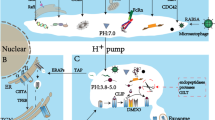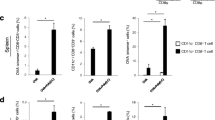Abstract
Dendritic cells (DC) can be cytotoxic towards tumor cells by means of TNF family molecules expressed on the cell surface of activated DCs. Tumor cells expressing appropriate receptors are killed by DC, generating a source of antigen to be presented to the immune system. It has not been investigated whether Langerhans cells (LC) are selectively cytotoxic to tumor cells. This is of particular interest for epithelial tumor cells that physically interact with LC in vivo. Among epithelial tumors, the oncogenic process of cervical tumors is relatively well defined by their Human Papillomavirus (HPV) mediated etiology. To study whether HPV16 E6 and E7 expressions, otherwise observed in cervical tumor cells, can sensitize normal cervical epithelial cells to DC and LC mediated killing, the E6 and E7 genes were introduced by retroviral transfection, and cells were subsequently used as targets in cytotoxicity assays. Expression of cytotoxic molecules by effector cells was measured in response to the pro-inflammatory cytokine IFN-γ; cytotoxicity was established and concomitant expression of receptor molecules was assessed on target cells. A correlation between the shrinkage of HPV16 E6 and E7+ tumors versus DC and LC infiltration was evaluated in a murine model of cervical cancer. DC and LC proved to be equally cytotoxic towards E6 and E7 expressing cervical epithelial cells. IFN-γ induced TRAIL expression by DC and LC, and inhibition of TRAIL partially blocked cytotoxic effects. Expression of TRAIL decoy receptors was reduced following introduction of E6 and E7 into host cells. Shrinkage of HPV16 E6 and E7 expressing tumors correlated with infiltration by S100+ DC and LC, co-localizing with apoptotic mouse tumor cells. In conclusion, DC and LC mediated killing may be exploitable for anti-tumor treatment.







Similar content being viewed by others
Abbreviations
- DC:
-
Dendritic cells
- HPV:
-
Human Papillomavirus
- IFN-γ:
-
Interferon-gamma
- LC:
-
Langerhans cells
- TGF-β:
-
Transforming growth factor-beta
- TNF:
-
Tumor necrosis factor
- TRAIL:
-
TNF- related apoptosis-inducing ligand
References
Aguilar-Lemarroy A, Gariglio P, Whitaker NJ et al (2002) Restoration of p53 expression sensitizes human papillomavirus type 16 immortalized human keratinocytes to CD95-mediated apoptosis. Oncogene 21:165–175
Basile JR, Zacny V, Münger K (2001) The cytokines Tumor Necrosis Factor-α (TNF-α) and TNF-related apoptosis-inducing ligand differentially modulate proliferation and apoptotic pathways in human keratinocytes expressing the human papillomavirus-16 E7 oncoprotein. J Biol Chem 276:22522–22528
Cassetti MC, McElhiny SP, Shahabi V et al (2004) Antitumor efficacy of Venezuelan equine encephalitis virus replicon particles encoding mutated HPV16 E6 and E7 genes. Vaccine 22:520–527
Chang AE, Li Q, Bishop DK et al (2005) Immunogenetic therapy of human melanoma utilizing autologous tumor cells transduced to secrete granulocyte-macrophage colony-stimulating factor. Hum Gene Ther 11:839–850
Chaudhari BR, Murphy RF, Agrawal DK (2006) Following the TRAIL to apoptosis. Immunol Res 35:249–262
Chaperot L, Blum A, Manches O et al (2006) Virus or TLR agonists induce TRAIL-mediated cytotoxic activity of plasmacytoid dendritic cells. J Immunol 176:248–255
Cohen EP, Kim TS (1994) Neoplastic cells that express low levels of MHC class I determinants escape host immunity. Semin Cancer Biol 5:419–428
Eiben GL, Velders MP, Schreiber H et al (2002) Establishment of an HLA-A*0201 human papillomavirus type 16 tumor model to determine to determine the efficacy of vaccination strategies in HLA-A*0201 transgenic mice. Cancer Res 62:5792–5799
Fanger NA, Maliszewski CR, Scholley K, Griffeth TS (1999) Human dendritic cells mediate apoptosis via cellular apoptosis-inducing ligand (TRAIL). J Exp Med 190:1155–1164
Fausch SC, Da Silva DM, Kast WM (2003) Differential uptake and cross-presentation of human papillomavirus virus-like particles by dendritic cells and Langerhans cells. Cancer Res 63:3478–3482
Feltkamp MC, Smits HL, Vierboom MP et al (1993) Vaccination with cytotoxic T lymphocyte epitope-containing peptide protects against a tumor induced by human papillomavirus type 16-transformed cells. Eur J Immunol 23:2242–2249
Guan B, Yue P, Clayman GL, Sun SY (2001) Evidence that the death receptor DR4 is a DNA damage-inducible, p53-regulated gene. J Cell Phys 188:98–105
Harwood CA, Surentheran T, Sasieni P et al (2004) Increased risk of skin cancer associated with the presence of epidermodysplasia verruciformis human papillomavirus types in normal skin. Br J Dermatol 150:949–957
Hougardy BM, Maduro JH, van der Zee AG et al (2006) Proteasome inhibitor MG132 sensitizes HPV-positive cervical cancer cells to rhTRAIL-induced apoptosis. Int J Cancer 118:1892–1900
Hunger RE, Sieling PA, Ochoa MT et al (2004) Langerhans cells utilize CD1a and langerin to efficiently present non-peptide antigens to T cells. J Clin Invest 113:701–708
Janjic BM, Lu G, Pimenov A et al (2002) Innate direct anticancer effector function of human immature dendritic cells. I. Involvement of an apoptosis-inducing pathway. J Immunol 168:1823–1830
Jimenez-Flores R, Mendez-Cruz R, Ojeda-OrtizJ et al (2006) High-risk human papillomavirus infection decreases the frequency of dendritic Langerhans’ cells in the human female genital tract. Immunology 117:220–228
Kayagaki N, Yamaguchi N, Nakayama M et al (1999) Involvement of TNF-related apoptosis-inducing ligand in human T cell-mediated cytotoxicity. J Immunol 162:2639–2647
Khorana AA, Rosenblatt JD, Sahasrabudhe DM et al (2003) A phase I trial of immunotherapy with intratumoral adenovirus-interferon-gamma (TG1041) in patients with malignant melanoma. Cancer Gene Ther 10:251–259
Kissenpfennig A, Ait-Yahia S, Clair-Moninot V et al (2005) Disruption of the langerin/CD207 gene abolishes Birbeck granules without a marked loss of Langerhans cell function. Mol Cell Biol 25:88–99
Kumamoto T, Huang EK, Paek HJ et al (2002) Induction of tumor-specific protective immunity by in situ Langerhans cell vaccine. Nat Biotechnol 20:64–69
Lin KY, Guarnieri FG, Stavely-O’Carroll KF et al (1996) Treatment of established tumors with a novel vaccine that enhances major histocompatibility class II presentation of tumor antigen. Cancer Res 56:21–26
Lu G, Janjic BM, Janjic J et al (2002) Innate direct anticancer effector function of human immature dendritic cells. II Role of TNF, lymphotoxin-alpha(1)beta(2), Fas ligand, and TNF-related apoptosis-inducing ligand. J Immunol 168:1831–1939
Lynch DH (1998) Induction of dendritic cells (DC) by Flt3 ligand (FL) promotes the generation of tumor-specific immune responses in vivo. Crit Rev Immunol 18:99–107
Matzinger P (1991) The JAM test. A simple assay for DNA fragmentation and cell death. J Immunol Methods 145:185–192
McFadden G, Kane K (1994) How DNA viruses perturb functional MHC expression to alter immune recognition. Adv Cancer Res 63:117–209
Muderspach L, Wilczynski S, Roman L et al (2000) A phase I trial of a human papillomavirus (HPV) peptide vaccine for women with high-grade cervical and vulvar intraepithelial neoplasia who are HPV 16 positive. Clin Cancer Res 6:3406–3416
Schuurhuis DH, Fu N, Ossendorp F, Melief CJ (2006) Ins and outs of dendritic cells. Int Arch Allergy Immunol 140:53–72
Sedman SA, Barbosa MS, Vass WC et al (1991) The full length E6 protein of human papillomavirus type 16 has transforming and trans-activating activities and cooperates with E7 to immortalize keratinocytes in culture. J Virol 65:4860–4866
Sholl LM, Hornick JL, Pinkus GS, Padera RF (2007) Immunohistochemical analysis of langerin in langerhans cell histiocytosis and pulmonary inflammatory and infectious diseases. Am J Surg Pathol 31:947–952
Streilein JW, Bergstresser PR (1984) Langerhans cells:antigen presenting cells of the epidermis. Immunobiol 168:285–300
Taube JM, Nichols AD, Bornman LS et al (2007) Langerhans cell density and high-grade vulvar intraepithelial neoplasia in women with human immunodeficiency virus infection. J Cutan Pathol 34:565–570
Tsutsumi K, Balguli N, Qi S et al (1992) Human Papillomavirus 16 DNA immortalizes two types of normal human epithelial cells of the uterine cervix. Am J Pathol 140:255–261
Van der Loos CM, Das PK, Van den Oord JJ, Houthoff HJ (1989) Multiple immunoenzyme staining techniques. Use of fluoresceinated, biotinylated and unlabeled monoclonal antibodies. J Immunol Methods 117:45–52
Vidalain PO, Azocat PO, Yagita H et al (2001) Cytotoxic activity of human dendritic cells is differentially regulated by double-stranded RNA and CD40 ligand. J Immunol 167:3765–3772
Wentzensen N, Vinokurova S, von Knebel Doeberitz M (2004) Systematic review of genomic integration sites of human papillomavirus genomes in epithelial dysplasia and invasive cancer of the female lower genital tract. Cancer Res 64:3878–3884
Acknowledgment
This study was supported by Penny Severns Fund, Illinois Department of Public Health and NCI grants CA74397 and CA97296. WMK holds the Walter A. Richter Chair.
Author information
Authors and Affiliations
Corresponding author
Additional information
I. Caroline Le Poole and W.M. ElMasri have contributed equally to this paper.
Rights and permissions
About this article
Cite this article
Le Poole, I.C., ElMasri, W.M., Denman, C.J. et al. Langerhans cells and dendritic cells are cytotoxic towards HPV16 E6 and E7 expressing target cells. Cancer Immunol Immunother 57, 789–797 (2008). https://doi.org/10.1007/s00262-007-0415-z
Received:
Accepted:
Published:
Issue Date:
DOI: https://doi.org/10.1007/s00262-007-0415-z




